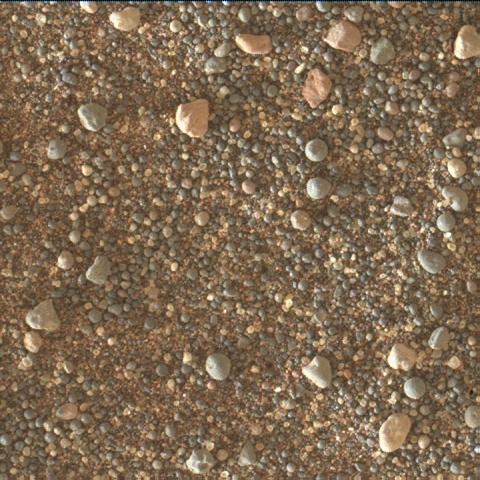MISSION UPDATES | January 4, 2021
Sol 2992: New Year's Resolution

NASA's Mars rover Curiosity acquired this image using its Mars Hand Lens Imager (MAHLI), located on the turret at the end of the rover's robotic arm, on January 2, 2021, Sol 2989 of the Mars Science Laboratory Mission. Credit: NASA/JPL-Caltech/MSSS. Download image ›
Here on Earth, people often use the start of a new year as an opportunity to adopt new resolutions for themselves. In planetary exploration, we often talk about a different kind of resolution, namely the spatial resolution of the cameras carried by a spacecraft. The Curiosity rover has a large suite of cameras with a range of spatial resolutions, one of which is the Mars Hand Lens Imager (MAHLI) camera. Located at the end of the rover’s robotic arm, MAHLI can be placed in close proximity to the surface to acquire incredibly high-resolution images of the grains within loose soil and rocks. And in the rover’s first plan of 2021, MAHLI’s imaging capabilities took center stage.
Right before the holiday break, Curiosity had been making her way across rubbly terrain towards a set of large sand ripples located within the Sands of Forvie. One of our primary motivations for visiting these ripples was to acquire high-resolution MAHLI images of the sand comprising them. When wind blows sand around, it naturally sorts it based on properties such as particle size, so close-up images of sand grains on different parts of a ripple can provide a means to study natural sorting processes and the winds controlling them. As seen in the image above (acquired at our current location on Sol 2989), MAHLI is able to resolve the size, shape, and color of individual grains of sand that are no larger than those you would find at a beach here on Earth.
As today provided our first opportunity to study the Sands of Forvie ripples after our New Year’s scuff, a major focus of our planning was to obtain a preliminary set of MAHLI images of the crest and trough of a prominent ripple in our workspace. These images will allow the team to plan a second set of even higher-resolution MAHLI images tomorrow. Other scientific measurements planned today included an APXS measurement to accompany MAHLI images of the ripple trough, ChemCam observations on sand targets “Carsaig East” and “Carsaig Arches," and Mastcam “change detection” images for tracking sand motion. Special morning and evening change detection images were also scheduled to help us better constrain the timing and direction of the winds responsible for shaping the Sands of Forvie ripples. A Mastcam stereo mosaic and Mastcam multispectral observation will provide additional data on the ripples in our immediate workspace. DAN and REMS measurements, as well as a small set of Navcam and Mastcam observations will also allow us to probe the current environmental conditions. The team is excited to be ringing in the new year at this interesting – and sandy – spot, and we are looking forward to exploring many more new terrains in 2021 as we continue our traverse up Mount Sharp.
